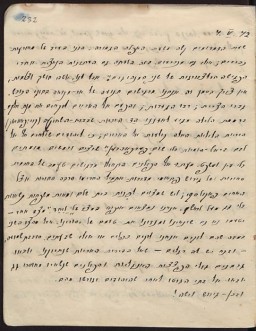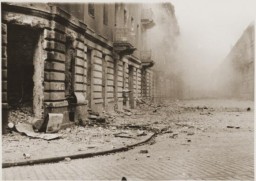
Spiritual Resistance in the Ghettos
Spiritual resistance during the Holocaust refers to attempts by individuals to maintain their humanity, personal integrity, dignity, and sense of civilization in the face of Nazi attempts to dehumanize and degrade them.
Springtime in the trees, in the fields, in the forest,
But here, in the ghetto, it's autumnal and cold,
But here, in the ghetto, it's cheerless and bleak,
Like the house of a mourner—in grief
The deprivations of ghetto life and the constant fear of Nazi terror made resistance difficult and dangerous but not impossible. In addition to armed resistance, Jews engaged in various forms of unarmed defiance. These included organized attempts at escaping from the ghettos into nearby forests, non-compliance with Nazi demands on the part of certain Jewish community leaders, illegal smuggling of food into the ghettos, and spiritual resistance.
Spiritual resistance refers to attempts by individuals to maintain their humanity, personal integrity, dignity, and sense of civilization in the face of Nazi attempts to dehumanize and degrade them. Most generally, spiritual resistance may refer to the refusal to have one's spirit broken in the midst of the most horrible degradation. Cultural and educational activities, maintenance of community documentation, and clandestine religious observances are three examples of spiritual resistance.
Culture and Education
Throughout occupied Poland, hundreds of clandestine schools and classes were organized inside the ghettos. Going to and from class in various apartments and basements, students hid their books under their clothing.
Jews smuggled books and manuscripts into many ghettos for safekeeping, and opened underground libraries in numerous ghettos. These underground libraries included the secret library at Czestochowa, Poland, which served more than 1,000 readers. Activists established a 60,000-volume library in the Theresienstadt ghetto, near Prague.
In the ghettos, Jews also engaged—insofar as possible—in a variety of cultural activities. Unlike the schools, these were not always forbidden by German authorities. Concerts, lectures, theatrical productions, cabarets, and art contests took place in many ghettos, despite the hardships of daily life.
Documentation of Community Life
Groups in many ghettos established secret archives and methodically wrote, collected, and stored reports, diaries, and documents about daily life in the ghettos. These efforts served to gather evidence on situation of Jews in occupied Europe and also sought to reaffirm a Jewish sense of community, history, and civilization in the face of both physical and spiritual annihilation.
The best known of these archives was that of the Warsaw ghetto, code-named Oneg Shabbat ("Joy of the Sabbath") and founded by historian Emanuel Ringelblum (1900–44). Some of the containers holding the archives were dug up from the rubble of the Warsaw ghetto after the war. The papers found inside have provided valuable documentation of life and death inside the ghetto. In the Bialystok ghetto, activist Mordechai Tenenbaum, who had come to Bialystok from Warsaw in November 1942 to organize the resistance movement, established ghetto archives modeled after Oneg Shabbat. An archive was also kept in the Lodz ghetto, but unlike the Warsaw and Bialystok archives, it was not entirely clandestine and therefore operated under certain limitations. These and many other smaller collections document daily life in the ghettos.
Religious Activities
The Germans forbade religious services in most ghettos, so many Jews prayed and held ceremonies in secret—in cellars, attics, and back rooms—as others stood guard. In Warsaw alone, in 1940, 600 Jewish prayer groups existed. Rabbinical authorities adjudicated religious disputes on the basis of religious law and attempted to adapt this law to the changed and difficult circumstances in which the community found itself. Prayer helped sustain morale, reaffirmed a cultural and religious identity, and supplied spiritual comfort. Many Orthodox Jews who opposed the use of physical force viewed prayer and religious observances as the truest form of resistance.
Critical Thinking Questions
- We often think first, or only, about violent resistance to an oppressive regime. What is the importance of spiritual resistance?
- Can spiritual resistance work in tandem with armed resistance? Or do you think they are mutually exclusive?





